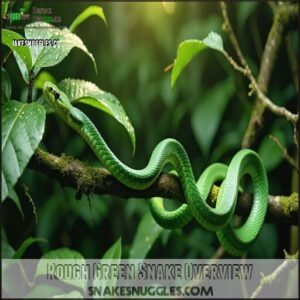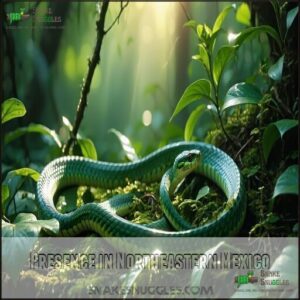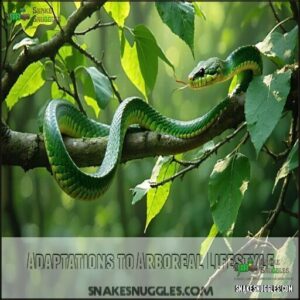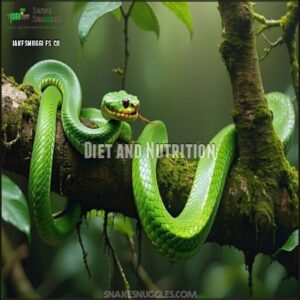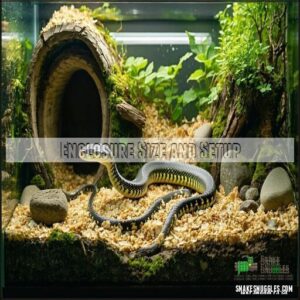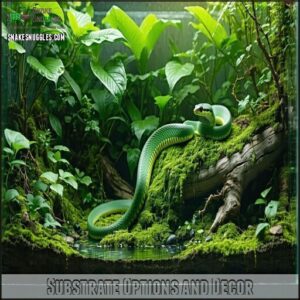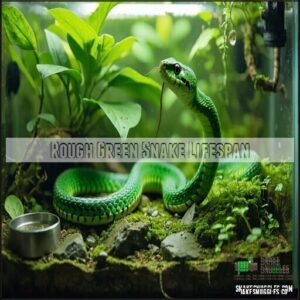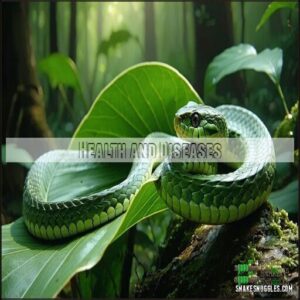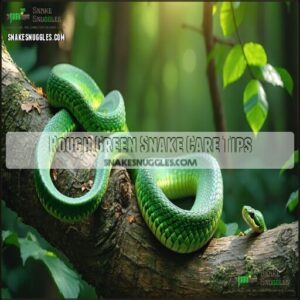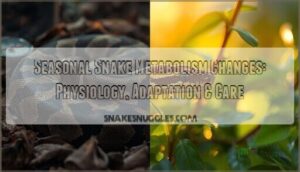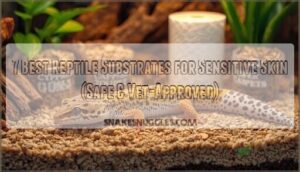This site is supported by our readers. We may earn a commission, at no cost to you, if you purchase through links.

It’s found swinging through trees in the southeastern U.S. and parts of Mexico, blending into leafy habitats like a living vine.
They mainly snack on insects and spiders, but they’ve got a soft spot for tree frogs too.
These snakes aren’t constrictors—they rely on speed and precision instead.
They’re diurnal, meaning they’re active during the day, and love to climb and swim.
With proper care, like a spacious enclosure and controlled humidity, they thrive in captivity.
Want more tips? There’s plenty to uncover!
Table Of Contents
- Key Takeaways
- Rough Green Snake Overview
- Habitat and Distribution
- Diet and Nutrition
- Behavior and Care
- Enclosure Requirements
- Rough Green Snake Lifespan
- Conservation Status
- Reproduction and Breeding
- Health and Diseases
- Rough Green Snake Care Tips
- Frequently Asked Questions (FAQs)
- Is the rough green snake poisonous?
- Are rough green snakes good pets?
- Why do rough green snakes turn blue?
- Are rough green snakes harmful?
- Can you pick up a rough green snake?
- Is a rough green snake a good pet?
- Do rough green snakes make good pets?
- Do rough green snakes like to be handled?
- How much does a rough green snake cost?
- Is rough green snake venomous?
- Conclusion
Key Takeaways
- They’re nonvenomous snakes that rely on their emerald green color for camouflage, making them harmless and easy to handle with care.
- They need a spacious enclosure with plenty of climbing branches, controlled humidity, and a temperature range of 72-90°F.
- Their diet focuses on soft-bodied insects like caterpillars and crickets, with occasional tree frogs or snails for variety.
- They’re diurnal, active during the day, and thrive when you minimize stress, offer a natural setup, and avoid frequent handling.
Rough Green Snake Overview
With their vibrant emerald green scales and slender, pencil-thin bodies, rough green snakes are masters of camouflage and elegance in the wild.
Females grow slightly larger than males, making these nonvenomous snakes a fascinating species to observe in nature or care for as pets.
Vibrant Emerald Coloration
The rough green snake’s vibrant emerald green color is more than just beauty—it’s a masterful camouflage tool.
This distinctive hue, influenced by genetic factors and diet, lets the snake disappear into vegetation.
Scale pigments create its striking snake appearance, though this green fades to blue after death.
Among green snake species, its emerald sheen truly stands out, with a unique emerald green color.
Keeled Scales and Slender Body
The keeled scales of the slender green snake give it a rough, textured appearance while aiding in protection.
Its sleek body proportions, combined with vibrant green camouflage, help it blend effortlessly into leafy environments.
Here are fascinating facts:
- Keeled scales feel rough, not smooth.
- Camouflage advantage hides it from predators.
- Post-mortem color fades to blue.
- Sexual dimorphism affects size.
Size Differences Between Males and Females
In terms of size, females are usually longer and larger in girth than males, showing noticeable sexual dimorphism.
Males may have slightly fewer ventral scales but more subcaudal counts.
Females average 947 mm in length, while males reach around 892 mm.
Their size differences help in identifying gender, making them a fascinating species to observe closely, with noticeable size variations.
Habitat and Distribution
You’ll find rough green snakes in moist, leafy habitats like woodlands, meadows, and areas near water.
Their range stretches across the southeastern United States and into northeastern Mexico, where they spend much of their time in trees or shrubs.
Preferred Environments and Vegetation Types
In their natural environment, these arboreal snakes thrive in areas bursting with greenery and moisture.
They love:
- Moist woodlands for shade and shelter.
- Water proximity, such as streams or ponds, to stay hydrated.
- Dense vegetation offering climbing surfaces.
- Piedmont regions and coastal plains with abundant trees.
- Shrubs and vines, perfect for hiding and hunting.
Range in Southeastern United States
The rough green snake thrives across the Southeastern United States, stretching through the Coastal Plain and Piedmont Region.
Its snake range skips higher elevations, favoring moist, lowlands with dense vegetation.
Habitat overlap occurs near waterways, where its vibrant green hue blends seamlessly.
Regional variations in snake habitat reflect an adaptable lifestyle, perfectly suited for North American forests, meadows, and overhanging branches, showcasing its ability to thrive in various environments with dense vegetation.
Presence in Northeastern Mexico
In Northeastern Mexico, rough green snakes (Opheodrys aestivus) thrive in lush habitats like Tamaulipas and eastern Nuevo León.
These regions offer the warm, moist environments they love.
Their Mexican distribution shows slight genetic variation compared to U.S. populations.
Conservation efforts are key, as habitat loss and climate impact threaten this part of the snake’s range, making preservation more critical than ever.
Adaptations to Arboreal Lifestyle
Rough green snakes are built for the treetops. Their slender body structure, keeled scales, and strong climbing skills help them grip branches and vines.
With excellent vision and sensory adaptations, they spot prey like insects and tree-dwelling snacks. Their vibrant green hue acts as perfect camouflage, blending into leafy surroundings, making them nearly invisible to predators and humans alike.
These snakes exhibit arboreal adaptations that allow them to thrive in elevated environments with arboreal adaptations.
Diet and Nutrition
Your rough green snake’s diet mostly consists of soft-bodied insects like caterpillars and spiders, but they’ll also eat tree frogs and snails if they get the chance.
They hunt without constricting, using their sharp vision and a keen sense of smell to find prey.
Primary Insect and Arthropod Prey
Green snakes love munching on soft-bodied bugs, sticking to a simple insectivore diet.
Their favorites? Caterpillars, spiders, and other wild insects!
Keep these points in mind:
- Choose soft-bodied prey like mealworms or caterpillars to match their insect softness preference.
- Offer a spider variety or small crickets for diversity.
- Prey size should fit their slim jaws—no oversized snacks!
Feeding on Tree Frogs and Snails
While insects make up most of their meals, rough green snakes occasionally snack on tree frogs and snails.
Frog consumption adds variety, while snail nutrition offers calcium for their bones.
These additions depend on prey availability in their habitat.
Though primarily insectivores, their ability to adapt their snake diet highlights their resourcefulness in finding sustenance beyond mealworms, crickets, and soft-bodied insects.
Non-constrictor Hunting Method
Relying on speed and precision, these insectivores excel at snapping up prey without constriction.
Arboreal hunting keeps them perched and ready to strike.
- Use quick bursts to catch insect prey.
- Depend on sharp visual acuity for movement detection.
- Snatch soft-bodied terrestrial arthropods like caterpillars.
- Strike speed guarantees prey capture before escape.
- Hunt actively, skipping unnecessary energy use.
Visual and Chemical Prey Detection
These snakes excel at spotting prey camouflage thanks to sharp visual acuity.
Their eyes detect movement in insect tracking, while scent cues guide them closer.
Sensory integration lets the rough green snake pinpoint insect prey even in dense vegetation.
A smooth blend of sight and smell guarantees their feeding is efficient, keeping them agile and ahead of predators in every hunt.
Behavior and Care
Rough green snakes are active during the day, spending their time climbing trees or gliding through foliage with ease.
Active by day, rough green snakes elegantly glide through foliage and trees, showcasing their vibrant green camouflage and arboreal agility.
To care for them, you’ll need to provide a secure, natural habitat that supports their solitary, arboreal lifestyle.
Diurnal Nature and Activity Patterns
During the day, rough green snakes stay active, basking in sunlight and hunting insects.
Their diurnal habits match their arboreal lifestyle, blending perfectly with leafy surroundings.
Here’s what to know:
- Daily Activity: Expect peak movement during warmer daylight hours.
- Basking Behavior: They enjoy soaking up heat to stay energized.
- Sleep Patterns: Quietly rest at night, hidden in dense vegetation.
Climbing and Swimming Abilities
Rough green snakes are powerful and agile climbers, relying on arboreal adaptations to navigate vertical surfaces.
They’re equally skilled in water, using an efficient swimming technique to escape predators or hunt near aquatic areas.
Their love for climbing makes branches and vines essential in enclosures, while a shallow water bowl supports their natural behaviors as good swimmers and arboreal escape artists.
Solitary Lifestyle and Social Interactions
While their climbing and swimming are impressive, rough green snakes prefer living solo.
In the wild, they’re shy and skittish, relying on their camouflage to avoid predators.
Captive interactions reveal a gentle snake temperament, yet they don’t enjoy social behavior or group dynamics.
Snake communication is subtle, and cage aggression is rare, making them peaceful yet independent companions.
Hibernation During Winter Months
When winter sets in, rough green snakes enter a state of Winter Brumation.
They adapt to temperature drops by seeking shelter under logs, leaf piles, or crevices, reducing activity to conserve energy.
During this period, food cessation is normal as their metabolism slows.
Proper thermoregulation in controlled environments mirrors this natural snake behavior, ensuring their habitat supports hibernation needs effectively.
Enclosure Requirements
You’ll need a spacious, secure enclosure to keep your rough green snake happy and healthy.
Make sure it mimics their natural habitat with plenty of climbing branches, plants, and a controlled temperature range.
Enclosure Size and Setup
When setting up your rough green snake’s home, choose an enclosure size of at least 18”L x 18”W x 36”H, ensuring plenty of climbing surfaces.
Larger tanks, like a 30-gallon one, are ideal for active snakes.
Add hiding boxes for comfort, maintain a temperature gradient (72-90°F), and use plants or decor enrichment to create a secure, stress-free environment.
For snakes that prefer burrowing, consider that proper substrate is essential to create a suitable environment.
Substrate Options and Decor
Choose substrates that maintain proper humidity and avoid dangerous materials. Non-toxic plants add life and cover, while hiding spots and climbing branches create safe spaces for your snake to explore.
- Use reptile carpet, paper towels, or inkless newspaper.
- Place climbing surfaces like branches or vines.
- Add hiding boxes for security.
- Fill 50% of the enclosure with plants.
Consider reptile carpet options for easy cleaning and maintaining a healthy environment with proper humidity.
Temperature and Humidity Control
Every rough green snake enclosure needs a basking spot temp of 90°F, with cooler sides at 72-80°F.
Nighttime drops to 70°F help mimic nature.
Humidity levels should stay between 50-75%, especially during shedding.
Use a hygrometer to monitor levels and a thermostat to calibrate temperatures.
A low-wattage basking light guarantees warmth without overkill.
Reptile owners often purchase a quality basking light for their pet’s enclosure.
Rough Green Snake Lifespan
You can expect a rough green snake to live 5 to 8 years in the wild, but with good care, they can reach up to 15 years in captivity.
Their lifespan depends on factors like diet, habitat quality, and how well you manage their health.
Average Captive Lifespan
In captivity, rough green snakes can live up to 5 years, sometimes reaching 15 with excellent care.
Captivity advantages like stable temperature, proper humidity, and consistent feeding extend their lifespan. Genetics and environmental factors also play a role.
A well-maintained enclosure with the right setup, along with attentive care quality, guarantees your snake enjoys a long, healthy life.
Factors Influencing Lifespan
A rough green snake’s lifespan depends on several factors. Genetics set the foundation, but captive care plays a huge role.
Provide a healthy diet and minimize stress to extend life expectancy. Environmental stressors, like temperature or humidity issues, can harm them.
Wild threats don’t apply in captivity, but proper care matters. To ensure the well-being of your snake, follow these guidelines:
- Avoid overhandling.
- Maintain stable habitat conditions.
- Offer diverse, nutritious food, which is crucial for a healthy diet.
Wild Lifespan and Comparison
In the wild, their lifespan averages 5-8 years, influenced by environmental factors like predation or pesticide exposure.
Captivity boosts survival rates, with fewer threats and better care. Curious about the contrast? Compare below:
Lifespan Factor Wild Captivity
Conservation Status
You’ll be glad to know that the rough green snake is classified as Least Concern on the IUCN Red List.
However, habitat loss, pesticides, and the pet trade pose ongoing risks to their populations.
IUCN Classification and Current Status
The rough green snake is listed as Least Concern on the IUCN Red List, meaning it’s not at immediate risk.
While population trends are stable overall, some areas report declines.
Conservation efforts focus on habitat protection and managing the pet trade.
Its conservation status highlights the importance of monitoring, ensuring this lively species keeps thriving in its natural environment.
They’re commonly found in open forest habitats.
Threats From Habitat Loss and Pesticides
Habitat loss from urban development and water contamination is shrinking the rough green snake’s home.
Pesticides harm their insect prey, causing population decline.
Road mortality adds to the snake decline as they cross busy areas.
Conservation efforts focus on preserving habitats and reducing pesticide use, but without careful action, this docile, vibrant green species may face even greater challenges.
Impact of Commercial Collection for Pet Trade
While habitat loss harms rough green snakes, another risk comes from the pet trade’s wild-caught practices.
Over-collection threatens their natural numbers and sparks concern for sustainability.
- Unregulated snake exploitation disrupts ecosystems.
- Captive breeding guarantees ethical sourcing.
- Wild population impact worsens without regulation enforcement.
- Responsible pet ownership reduces demand for wild-caught snakes.
- Support laws protecting wild snake habitats to prevent habitat loss.
Reproduction and Breeding
In terms of reproduction, rough green snakes are egg-laying reptiles that typically mate in spring.
Females lay their eggs in warm, hidden spots, and the young hatch fully independent, ready to explore the world.
Mating and Egg-Laying
Snake reproduction takes patience, as their mating habits are fascinating.
During the breeding season, males perform courtship rituals like chin rubbing and head jerking.
Females lay a clutch size of 2-14 eggs in moist spots like tree hollows.
Here’s a quick overview:
| Key Aspect | Details | Timing |
|---|---|---|
| Courtship Rituals | Chin rubbing, head jerking | Spring or occasionally Fall |
| Clutch Size | 2-14 eggs | June–July |
| Egg Incubation | Moist, hidden locations | 30+ days |
The table provides a detailed look at the breeding season, including courtship rituals, clutch size, and egg incubation periods, offering a comprehensive view of snake reproduction.
Incubation and Hatching
During incubation, rough green snake eggs thrive with an ideal temperature range of 75-85°F and steady egg humidity.
A moist incubation medium like vermiculite helps guarantee healthy embryological development.
Hatchlings emerge in late summer at around 7-8 inches long.
- Maintain consistent humidity levels.
- Avoid extreme temperature changes.
- Keep the clutch size undisturbed during incubation.
Sexing and Size Differences
After eggs hatch, you’ll notice rough green snakes show sexual dimorphism.
Females are longer (up to 947mm) and heavier, while males are leaner.
Females have more ventral scales but fewer subcaudals.
Girth differences make females slightly bulkier.
These size contrasts are subtle, so sexing often requires tail base inspection or probing, especially when comparing length or growth patterns.
Health and Diseases
Keeping your rough green snake healthy means watching for common issues like respiratory infections and scale rot.
These problems can often be avoided with proper care, but knowing the warning signs is key.
Common Health Issues
You’ll notice rough green snakes are hardy, but they can face health issues like respiratory infections, fungal infections, and scale rot.
Bacterial infections and parasites may also pop up, especially in dirty enclosures.
Keep their habitat clean and stress levels low. A healthy routine keeps these vibrant little climbers thriving, avoiding these common problems altogether.
Prevention is always easier than treatment.
Respiratory Infections and Fungal Problems
Respiratory infections and fungal infections can quickly affect snake health if humidity levels are too high or the enclosure isn’t clean.
Early detection is key—look for wheezing or unusual skin patches.
Infection prevention starts with steady humidity and regular cleaning, and treatment options include veterinary care and antibiotics.
Prioritize proper husbandry to avoid these health issues and keep your snake illness-free.
Scale Rot and Bacterial Infections
Scale rot and bacterial infections can sneak up on your snake if its habitat isn’t clean or humid enough.
Look for sores or discolored scales to catch it early. Prevent these health issues with proper husbandry.
Here’s how:
- Keep the enclosure dry and clean.
- Avoid sharp decor that damages scales.
- Provide a balanced diet.
- Seek veterinary care if symptoms worsen.
Early detection is key, as untreated scale rot can lead to necrotic dermatitis.
Rough Green Snake Care Tips
Caring for a rough green snake means keeping its habitat clean, feeding it the right insects, and handling it gently.
With a bit of effort, you’ll create a comfortable home that keeps your snake healthy and stress-free.
Feeding Frequency and Prey Selection
Feeding your Rough Green Snake takes a gentle touch. Offer soft-bodied insects like caterpillars, moths, or spiders. Gut-load prey with nutrients, and dust with calcium for a balanced diet.
Feed every 2-3 days, using prey smaller than the snake’s width. Live or pre-killed? Pre-killed reduces injury risks.
Seasonal variations affect prey preferences, so keep options ready! They primarily eat insects, so supplement feeders with calcium and vitamins.
| Feeding Tips | Details |
|---|---|
| Prey Types | Caterpillars, moths, spiders, crickets |
| Feeding Frequency | Every 2-3 days |
| Prey Size | Smaller than the snake’s body width |
| Nutritional Boost | Gut-load prey and use calcium dusting |
| Live vs. Pre-killed | Pre-killed reduces stress and injury risks |
Handling and Taming
Handling rough green snakes takes a gentle approach, as they’re skittish by nature.
Gradual acclimation helps reduce stress and bite risk. Use safe restraint and never squeeze. Avoid stressing them by limiting handling to short sessions.
For snake handling success, consider the following tips:
- Watch for stress signs.
- Use feeding tweezers.
- Handle near the floor.
- Stay calm and patient.
- Prioritize observation.
Habitat Maintenance and Cleaning
Keeping the enclosure clean is key for a happy snake.
Spot-check the substrate daily for droppings, and replace it every few weeks. Maintain water hygiene by scrubbing the dish regularly.
Trim live plants to avoid clutter, and check for mold.
Maintain temperature and humidity using a hygrometer. You may want to replace snake bedding material regularly.
Proper misting prevents odor while keeping everything fresh and natural.
Frequently Asked Questions (FAQs)
Is the rough green snake poisonous?
Imagine a green ribbon gliding through branches—it’s not dangerous.
The rough green snake isn’t poisonous.
It’s as harmless as a garden worm and relies on its striking color to blend into nature.
Are rough green snakes good pets?
Yes, rough green snakes make great pets for beginners.
They’re small, docile, and easy to care for.
Their bright green color adds charm, but they do best in spacious, natural enclosures with proper climbing options.
Why do rough green snakes turn blue?
When life fades from a rough green snake, its vibrant green scales reveal an unexpected secret—blue hues emerge as its yellow pigments degrade.
It’s nature’s quiet chemistry, turning their once-lively camouflage into a final masterpiece.
Are rough green snakes harmful?
Rough green snakes aren’t harmful; they’re nonvenomous and generally calm.
They might squirm if handled but won’t bite.
Their bright green color is more for camouflage, not danger, making them harmless to people and pets.
Can you pick up a rough green snake?
You can handle them gently since they’re nonvenomous and docile.
But move slowly—they’re skittish and might dart.
Their delicate bodies need care, so never grip tightly. Think of it as holding a fragile twig.
Is a rough green snake a good pet?
They make great pets if you enjoy observing over handling.
Their bright green color is striking, they’re low-maintenance, and mainly need a spacious, naturalistic setup.
Just be gentle—they’re delicate and stress easily.
Do rough green snakes make good pets?
They’re excellent pets if you enjoy observing rather than holding.
Their bright green color and calm nature shine, but their care needs—like spacious enclosures and a diet of soft-bodied insects—require commitment and attention to detail, making them a choice that demands commitment.
Do rough green snakes like to be handled?
They don’t enjoy handling like a dog enjoys belly rubs.
These snakes stress easily and prefer observing from their enclosure.
If you must handle them, keep it brief and gentle to avoid causing fear.
How much does a rough green snake cost?
You get what you pay for, and rough green snakes typically cost between $10 and $20, depending on their size and source.
They’re affordable, but don’t forget to budget for a proper setup!
Is rough green snake venomous?
No, rough green snakes aren’t venomous.
They’re completely harmless and rely on their bright green color to blend into trees instead of using venom.
You can handle them without worry, just be gentle!
Conclusion
Caring for a rough green snake offers a unique chance to observe its beauty and fascinating behaviors.
These emerald-colored, diurnal climbers thrive in well-maintained enclosures that mimic their natural habitats.
With a diet focused on insects and occasional amphibians, proper feeding guarantees their health.
They also require controlled humidity and space to climb or swim.
By understanding their needs—from habitat setup to gentle handling—you’ll help your snake live a long, stress-free, and active life.
- https://srelherp.uga.edu/snakes/ophaes.htm
- https://esajournals.onlinelibrary.wiley.com/doi/pdfdirect/10.1002/ecs2.3153
- http://www.louisianaherps.com/rough-greensnake-opheodrys-.html
- https://www.naturalheritage.state.pa.us/factsheets/11545.pdf
- https://mdc.mo.gov/discover-nature/field-guide/northern-rough-greensnake

